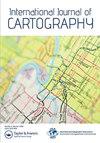Incorporating ideas of structure and meaning in interactive multi scale mapping environments
IF 0.9
Q4 COMPUTER SCIENCE, INFORMATION SYSTEMS
引用次数: 1
Abstract
ABSTRACT Web based, slippy, scalable maps are common place. Interacting with such digital maps at varying levels of detail is key to interpretation, and exploration of different geographies. The process of abstraction remains key to the immediate and successful interpretation of their many structures and geographical associations found at any given scale. Meaning is derived from such recognisable structures and map generalisation plays a critical role in communicating an entity's most characteristic and salient qualities. But what are these structures? How (and why) do they change over scale? Why are such questions relevant to automated mapping? In this paper we reflect on the value of perceptual studies and reconsider the context in which map generalisation now takes place. We review developments in pattern recognition techniques and the role played by machine learning techniques in identifying high level structures in abstracted maps. The benefits of their application include derivation of ontological descriptions of landscape, identification and preservation of salient landmarks across scales. We argue that a 'structuralist based approach' provides a more meaningful basis for measuring success and achieving more meaningful outputs. Ultimately the ambition is greater levels of automation in map generalisation, particularly in the context of web based solutions.在互动式多比例尺绘图环境中整合结构与意义的概念
基于Web的、流畅的、可伸缩的地图是常见的地方。在不同的细节层次上与这些数字地图互动是解释和探索不同地理的关键。抽象的过程仍然是直接和成功地解释它们在任何给定尺度上的许多结构和地理联系的关键。意义来源于这种可识别的结构,而地图概括在传达实体的最特征和突出品质方面起着关键作用。但是这些结构是什么呢?它们是如何(以及为什么)随着规模而变化的?为什么这些问题与自动映射相关?在本文中,我们反思了感知研究的价值,并重新考虑了地图概括现在发生的背景。我们回顾了模式识别技术的发展以及机器学习技术在识别抽象地图中的高级结构方面所起的作用。其应用的好处包括引出景观的本体论描述,识别和保护跨尺度的显著地标。我们认为,“基于结构主义的方法”为衡量成功和实现更有意义的产出提供了更有意义的基础。最终的目标是在地图泛化方面实现更高水平的自动化,特别是在基于web的解决方案的背景下。
本文章由计算机程序翻译,如有差异,请以英文原文为准。
求助全文
约1分钟内获得全文
求助全文
来源期刊

International Journal of Cartography
Social Sciences-Geography, Planning and Development
CiteScore
1.40
自引率
0.00%
发文量
13
 求助内容:
求助内容: 应助结果提醒方式:
应助结果提醒方式:


